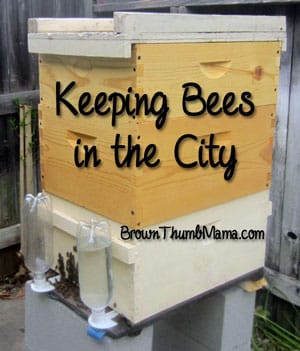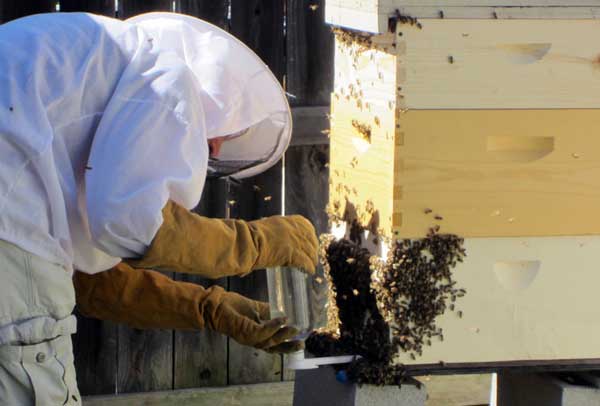This post may include affiliate links.
If you make a purchase, I'll earn a small fee at no extra cost to you.
The conversation goes something like this: “You have BEES? In your BACKYARD?” Then I get the questions, all in one long breath: “Whatiftheystingthekids! Whatiftheygetinthepool! Whywouldyoudothat?”
Well, it’s been a month now, and I am happy as a clam that I have bees in my backyard. Hubby is still unconvinced. Some of the questions above may have come from him…
I had an easy start with beekeeping, since my cousin set me up with an extra hive and bees. He brought them over, all sealed up in their hive, and we set them up in a corner of the backyard.
They are not aggressive, and you would have no idea they were there without searching. Every plant in my garden is pollinated and happy! Within minutes of opening the hive, the bees flew out and came back with tummies full of nectar and pollen all over themselves. I’m looking forward to having my own honey and beeswax for recipes and DIY projects.
Here are some fun things I’ve learned in my first month of beekeeping:
Anatomy of a hive
The boxes in the beehive are called supers.
Inside the supers are these frames, where the bees build the comb. The frames can be removed easily so you can harvest the honey and/or the beeswax.
Bees live in the bottom super, and the top super(s) are where the bees store the extra honey. This is where we will harvest from.
In the top picture, you can see bottles of water on the outside of the hive. This keeps them from drinking out of the pool. They have been drinking about a liter of water a day.
Bee facts
A typical beehive can contain as many as 60,000 bees.
As the weather gets warm in the spring, female worker bees collect nectar from flowers within a 4-mile radius of the hive. Male bees, or drones, do not forage for the hive.
As the bees go from flower to flower drinking nectar, they get pollen on their back legs and pollinate the flowers. This is great for the garden.
The bees carry the nectar back to the hive, and then they fan the nectar to evaporate most of the water. What’s left is honey.
A well cared-for hive can produce from 30 to 100+ pounds of honey per season.
Cool Beekeeper Lingo
Bearding: this is how people describe it when the bees are hanging out on the outside of the hive and chillin’. You can see below that they are clustered on the front of the hive, sort of in the shape of a man’s beard. They do this to keep the honey at the correct temperature and allow for airflow in the hive. When it’s really hot outside, they fan their wings to push air inside the hive.
Orienting: we observed this when my cousin opened up the hive entrance for the first time. The bees fly out of the hive, and zoom around in circles for a few minutes. It sets their “internal compass” so they can find their way back home.
Propolis (bee glue): a resinous substance that bees collect from the bark and buds of various trees. They use this to fill crevices, and fix and varnish their combs. The supers are stuck together with propolis.
Waggle dance: how the bees tell each other where the good flowers are. This figure-eight dance relays information about the direction and distance to patches of flowers yielding nectar and pollen, to water sources, or to a new housing location. Amazing, huh?
Do you have backyard bees? Share your beekeeping tips in the comments!
P.S. Don’t worry, Mom. Nobody has been stung. 🙂






